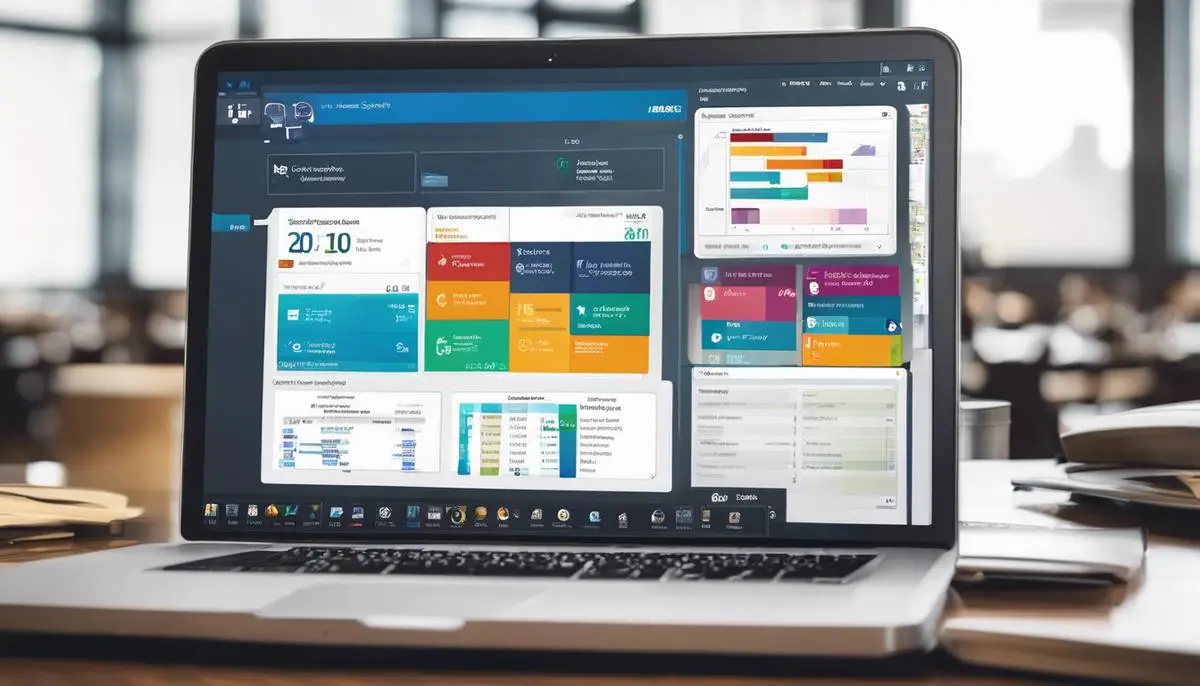In today’s rapidly evolving digital landscape, church leaders are increasingly turning to technology to streamline the complexities of managing their congregations. Church planning software has emerged as a game-changer, revolutionizing how religious organizations handle day-to-day operations, foster community, and nurture their members’ spiritual growth. This essay embarks on a comprehensive journey through the multifaceted world of these technological tools, shedding light on their key features, integration capabilities, and the critical role they play in crafting a seamless administrative fabric. As we navigate through the intricacies of scalability, customization, security, and compliance, we will paint a vivid picture of the pivotal position church planning software holds in the harmonious convergence of faith and modernity.
Key Features of Church Planning Software
In the fast-paced world we’re navigating, efficiency is paramount, and nowhere is this truer than in the management of faith-based organizations. Enter church planning software: an indispensable tool for modern congregations. Let’s dive into what makes this software not just useful, but absolutely vital.
Firstly, church planning software addresses a fundamental need: organization. With an array of features designed to consolidate schedules, manage donor databases, and track finances, these programs are virtual lifelines for busy church staff. Say goodbye to double-booked events and misplaced financial records; everything is neatly organized in one place.
Secondly, communication is key in cultivating a strong community, and this is where church planning software excels. It streamlines communication, allowing for the seamless dissemination of information through newsletters, alerts, and social media integrations. In today’s fast-paced digital environment, staying connected with your congregation is non-negotiable.
Moreover, church planning software is a beacon of efficiency when it comes to event planning. Coordinating volunteers, scheduling resources, and planning worship services can be done with precision and ease. This frees up precious time for church leaders, allowing them to focus on their core mission: serving their community.
Financial transparency and management are yet another compelling reasons for adopting this software. With features for giving, budgeting and reporting, churches can maintain impeccable financial records. Transparency is not just expected in today’s economy, it’s demanded, and church planning software delivers.
Finally, scalability is where this software truly shines. As congregations grow, so do their administrative demands. This software scales with your organization, ensuring that the needs of both small and mega-churches are met with equal adeptness.
In conclusion, church planning software is far from a mere convenience—it’s a strategic asset. With its unparalleled ability to streamline operations, improve communication, assist with event management, ensure financial clarity, and scale with your church, it’s clear that such software isn’t just a nice-to-have; it’s an operational imperative.
Integration Capabilities
In a landscape where the intersection of technology and spirituality continues to evolve, integration proves to be a lynchpin in revolutionizing church management. The modern church demands efficiency that echoes the seamlessness of digital experiences congregants encounter in their daily lives. Integration extends benefits far beyond the basics of organization and communication; it paves the way for strategic engagement, resource optimization, and intelligent data analysis that can boost overall church growth.
By ushering in smart forms of member engagement, management systems with integrated capabilities enable churches to tap into a deep well of data-driven insights. Imagine tracking attendance trends, discerning active volunteer segments, and identifying areas where community outreach can be bolstered. This is not just data for the sake of numbers—it’s actionable intelligence that fosters a proactive approach to ministry.
With resource optimization, time reigns supreme. Efficient church management isn’t just about doing more with less—it’s about maximizing the value of every minute. Integrated platforms allow for automated workflows that can alleviate the burden of redundant tasks. The time saved can be redirected into the more human aspects of ministry, nurturing relationships, and personal spiritual guidance that technology alone cannot provide.
Data from integration systems also powers an often-overlooked facet of church management: predictive analysis. Decoding patterns within the data can lead to foresight regarding resource allocation, potential giving campaigns, and even the scheduling of events in alignment with member availability and interests. This foresight translates into staying a step ahead in planning and fostering a thriving church community.
Lastbly, integration brings about accountability and stewardship that align with biblical principles. Advanced reporting functions serve as a testament to diligent management, cultivating trust within the congregation. Additionally, integrated platforms empower church leadership with oversight on all fronts—from monitoring utility costs to keeping a watchful eye on mission fund allocations. This transparency builds a foundation of trust that enriches fellowship.
To encapsulate, integration in church management isn’t merely about keeping up with the times; it’s a strategic leap into a future where the heart of the church’s mission meets the edge of technology’s efficiency. As churches grow, so too must their approaches to managing the precious resources entrusted to them. Integration is not just a tool; it’s an evolution in stewardship, enabling a responsive, connected, and forward-thinking church.

Scalability and Customization
Why Scalability and Customization Are Revolutionizing Congregation Management
In a rapidly evolving world, congregations, irrespective of their size, confront the challenge of staying connected and responsive to their members’ needs. The answer? Scalability and customization in the congregation management tools they deploy. These twin pillars are revolutionizing how congregations operate, enabling them to not only match pace with growth but also tailor their approach to each unique member.
Consider the profound impact of a management system that grows in sync with a congregation. A small community may start with a handful of faithful. As the congregation expands, its needs diversify—more events, larger donations, an extended reach. Scalability means that the initial investment in management infrastructure becomes a lasting one, evolving to handle hundreds or even thousands of individuals without skipping a beat. There’s no need for costly overhauls or transitions; the system flexes to accommodate growth.
Equally indispensable is customization. Each congregation has a unique heartbeat—a distinct set of values, priorities, and community demographics. Customization allows for a bespoke experience, from personalized member communication to tailored fundraising campaigns. It speaks directly to the heart of the community, ensuring relevance and reinforcing connection.
Furthermore, congregation leaders are empowered to harness digital tools that enable insightful stewardship. Scalability ensures these tools are not outgrown, while customization offers the analytics specific to the congregation’s context. This combination leads to informed decision-making, allows for precise member care, and puts resources where they are most needed, all without diluting the organization’s core mission.
In summary, scalability ensures no congregation outgrows its management system, future-proofing its operations. Customization makes certain that each member feels valued and aligned with the congregation’s vision. This powerful duo of scalability and customization isn’t just a game-changer; it’s setting the new standard for excellence in congregation management. With these elements in place, churches can confidently rise to the calling of serving their communities, now and in the future.
Security and Compliance
In the fast-paced world of modern ministry, church leaders must prioritize robust security for planning software as a critical aspect of their operational framework. Here are the indispensable security measures to safeguard your congregation’s data:
Data Encryption: Information is an asset and a vulnerability. Implementing state-of-the-art encryption for both data at rest and in transit is an absolute must. This means converting sensitive information into a secure format that is unreadable to unauthorized users, ensuring confidentiality even in the event of a breach.
Multi-Factor Authentication (MFA): Passwords alone no longer suffice. MFA adds layers of defense, requiring users to provide multiple proofs of identity before gaining access. This could be a combination of something they know (password), something they have (a phone), or something they are (biometrics).
Regular Security Audits: Complacency is the enemy of security. Perform periodic security assessments to identify vulnerabilities and reinforce the software’s defenses. This proactive approach to security hygiene prevents exploitation and prepares for emerging threats.
Role-Based Access Controls (RBAC): Insightful leaders understand that not all users need equal access. RBAC systems grant permissions based on roles within the organization, minimizing the risk of insider threats and ensuring individuals only have access to the information necessary for their roles.
Backup and Disaster Recovery: Prayer is powerful, but backup is practical. Any robust church management system must include automated, secure backup and a clear disaster recovery plan to ensure continuity of ministry in the face of unforeseen data loss or system outages.
Compliance with Standards: Adhering to data protection standards such as GDPR, CCPA, or other relevant regulations not only demonstrates good stewardship but also protects the church from legal repercussions.
Education and Training: An informed team is the first line of defense. Regular training sessions on best security practices can fortify against social engineering attacks which often exploit human error.
By integrating these essential security measures, church leaders can assure their congregation that their data is handled with the utmost respect and protection. This not only fortifies the church’s digital infrastructure but also reinforces the trust between the church and its members, solidifying that their spiritual home is also a sanctuary for their personal information. In the digital age, securing church planning software is not merely an administrative task—it’s a sacred responsibility.
Cost-Benefit Analysis
Harnessing Tech to Empower Faith-Based Communities: Security in Church Planning Software
In an age where cyber threats are as prevalent as they are relentless, investing in church planning software infused with robust security features is not just an option—it’s a necessity. Leverage this formidable tech arsenal to ensure that the sanctity of your church’s digital realm remains unviolated, turning security from a potential liability into an unwavering pillar of your organizational prowess.
Data Encryption: The Guardian at the Gate
The bedrock of digital security, data encryption converts your sensitive information into coded messages that can’t be deciphered without the key—namely, your consent. Think of it as a sanctuary for your church’s data, safeguarding everything from personal information to giving records, ensuring that confidentiality reigns supreme.
Multi-Factor Authentication (MFA): The Sentinel of Verification
Double down on defense with MFA. By requiring multiple forms of identification before access is granted, your church erects a formidable barrier against unauthorized entry. It’s akin to a series of checks and balances that fortify trustworthiness and slam the door on potential intruders.
Regular Security Audits: The Watchful Eye
Vigilance is key to ensuring that security measures are up to date and effective. Regular security audits act as a diagnostic tool that identifies vulnerabilities, so they can be addressed before they pose a threat. Consider this the equivalent of a health check-up for your software’s immunity against cyber maladies.
Role-Based Access Controls (RBAC): The Gatekeepers of Authority
Not everyone needs the keys to every room. RBAC establishes clear roles within your church management software, determining who can access what. This level of control prevents information overload and mitigates internal risks by aligning access with responsibility.
Backup and Disaster Recovery: The Assurance of Continuity
In the unforeseen event of data loss, robust backup and disaster recovery options act as assurance of business continuity. Just as Noah built the ark to weather the flood, your church must prepare its digital haven to withstand any potential storm.
Compliance with Standards: The Seal of Approval
Meeting and maintaining industry standards isn’t just about ticking off checkpoints; it’s about embodying a culture of conscientiousness. Compliance ensures that your software adheres to legal and ethical practices, offering a seal of approval that speaks volumes about your commitment to security.
Education and Training: The Enlightened Defense
The best defense is a well-informed team. Equip staff and volunteers with the knowledge and training to recognize threats and use the software safely. An enlightened congregation is a cyber-secure congregation, where each individual becomes a proactive guardian of the digital faith.
In the grand tapestry of faith-based community management, security is the thread that weaves through every aspect, strengthening the fabric of trust and commitment between a church and its members. Investing in church planning software that encompasses these pivotal security features isn’t just prudent—it’s an act of stewardship that protects, empowers, and ultimately solidifies the future of faith in the digital age.

The exploration of church planning software culminates in a vivid understanding of its transformative power within the ecclesiastical domain. As we have seen, the right tools can uplift the spiritual mission by providing robust support for administrative duties, thereby allowing clergy and lay leaders to return to the heart of their work—ministry and service. By integrating advanced features, ensuring data security, and weighing the cost against tangible and intangible benefits, churches can navigate the digital realm with confidence and grace. Embracing these solutions, faith communities are not only preparing for the future, but are also reinvigorating their core calling in the present, standing at the forefront of innovation while remaining steadfast in their timeless values.













